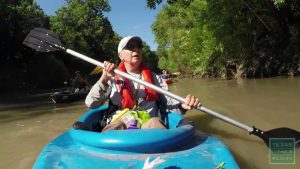TPW Magazine–Texas Water Safari
Wednesday, June 6th, 2018This is Passport to Texas
This Saturday, June 9th, the 56th Annual Texas Water Safari gets underway. Known as the World’s Toughest Canoe Race, individuals and teams of paddlers endure the grueling non-stop, 262 mile trip from San Marcos to Seadrift.
Read a nail-biting account of the trek written by adventurer, Russell Roe, for the June issue of Texas Parks and Wildlife magazine. It’s another installment of the magazine’s year of Epic Texas Adventures.
Roe captures the spirit of the event as he follows novices and seasoned veterans alike, as they wipe out at rapids and lose all their gear, negotiate log jams, suffer blazing heat, oppressive humidity, the indignity of biting insects.
These intrepid souls paddle on, despite the dark of night, losing their way, and the weight of exhaustion that descends on them all. Paddlers have a 100 hour time frame to reach their destination.
What’s even more remarkable is there’s no big cash prize at the end of the race. Just memories and bragging rights. Talk about an epic adventure.
Read this thrilling story called Epic Texas Challenge — Texas Water Safari by Russell Roe in the June issue of Texas Parks and Wildlife magazine. On Newsstands now.
That’s our show…. brought to you in part by Ram trucks: built to serve.
For Texas Parks and Wildlife…I’m Cecilia Nasti.







 Passport to Texas is a
Passport to Texas is a  Passport to Texas is made available by:
Passport to Texas is made available by: